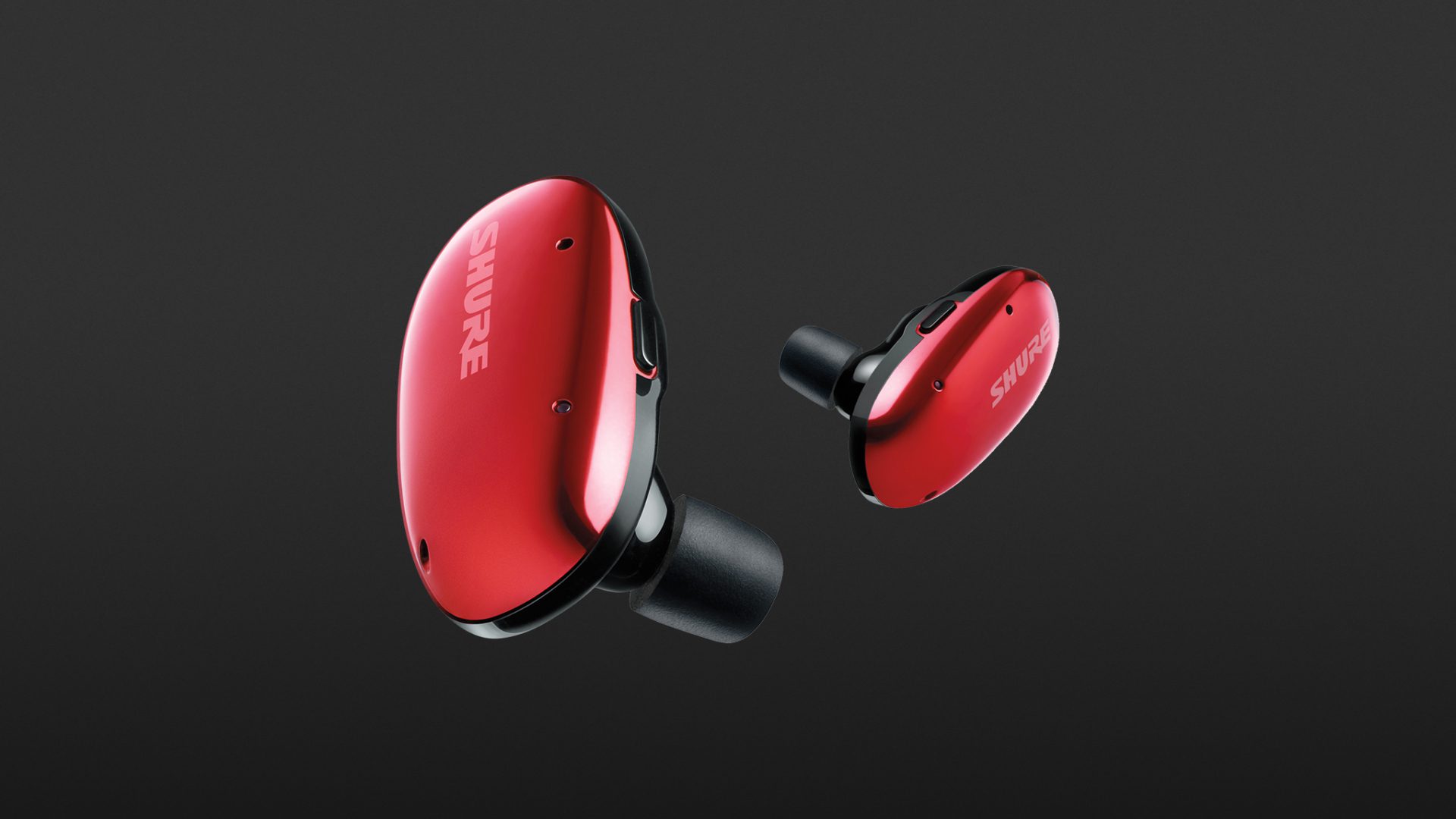Shure’s Aonic Free have enriched the consumer market with a pair of true wireless in-ears that provide a precise, balanced basic sound and score points with their extensive personalisation options via the app. The outstanding EQ section, which enables flexible, individual sound adjustment, deserves a special mention. In addition, the ambient mode offers an effective and finely adjustable amplification of external noise, even if the existence of background noise could be seen as a shortcoming. The rather large charging case seems somewhat impractical, as it is not suitable for transport in normal trouser pockets. Otherwise, however, these cable-free in-ears impressed us with their high functionality and impeccable all-rounder qualities.
- Sturdy fit
- Quick charging function
- App connection with extensive (sound) customisation options
- Support aptX and AAC
- No LDAC
- Quite large charging case
- Ambient mode with perceptible background noise
The wireless Shure Aonic Free in-ears feature versatile functionality and can be flexibly adapted to one’s own needs via connection to an app. This applies to both the sound and the operation, as well as the amplification of external noise in ambient mode.
The well-established American professional audio technology manufacturer supplies the Shure Aonic Free with foam earpieces from Comply in three sizes, ensuring a stable fit. In addition, the proprietary sound isolation technology is supposed to provide high passive shielding. We can confirm that the Aonic Free emit very little sound to the outside and that there is a significant attenuation of external noise typical of in-ear systems. The presence of exceptionally high isolation properties, on the other hand, could not be determined.
Although these earphones, at seven and a half grams per side, are not ultra-lightweight and the futuristic-looking design does not necessarily look delicate, their wearing comfort is decidedly long-lasting. Although the housings protrude beyond the ears, they are very flat, which makes it possible to wear these in-ears under a loose-fitting hat during cold weather.
Battery life
With a runtime of seven and a half hours at high volume, the Aonic Free proved to be quite enduring in our battery test. A total of almost 24 hours of listening time was achieved, as these in-ears can be fully charged twice in their charging case and once again with a remaining capacity of 25 per cent. One charging cycle of these earphones takes a good two and a half hours. For more spontaneous use, however, the quick-charge function can be used, and this allows for one hour of listening time after fifteen minutes of power supply. The battery reserve of the charging case is restored in less than 60 minutes via the available USB-C port, for which a USB-C to USB-A charging cable is included. However, it has to be accepted that the case seems rather large compared to the competition and, with dimensions of 89 x 53 x 32 millimetres, does not have a pocket-friendly format.
Operation
Pairing the Aonic Free, which support Bluetooth standard 5.0 and single-sided use in single mode, can be done by removing them from the case. This turns the system on and automatically puts it into pairing mode while placing them back in the charger turns the in-ears off. However, the earpieces can also be switched on and off manually independently of the charging case by pressing and holding the multifunctional buttons located on the upper surface of the housing, and this increases the life expectancy of the batteries. However, we noticed that the current firmware (version 1.3.10.0) does not allow pairing with different devices. For example, if you want to establish a Bluetooth connection to a laptop or a tablet after your smartphone has already been paired, you must first perform a reset. Currently, another device can only be connected if both buttons have been pressed for seven seconds while the in-ears are in the case, but this could be fixed with an update.
One very convenient feature is that the Aonic Free’s button assignment can be individually adjusted via the app. In the factory setting, simply pressing the button controls playback and is used to answer and end phone calls. Ambient Mode can be activated or deactivated by pressing twice while pressing three times calls up voice assistants. Volume control can be done by pressing and then holding, which reduces the playback level on the left and increases it on the right. If you’re missing title navigation, you can select this function at any time via the app, for example, instead of the voice assistant. Even the preferred EQ setting can be switched on and off via a button if desired, and this is cleverly done. The stability of the wireless connection also made a positive impression, as several rooms could be bridged without any problems and a range of a good ten metres could be achieved within an urban environment.
ShurePlus Play App
The app for the Aonic Free (on Android and iOS) leaves little to be desired and offers numerous configuration options in addition to firmware updates and individual button assignment. These include an automatic switch-off function via timer as well as the option to define the sound of the headphones for individual events by providing multilingual voice announcements or tones whose volume can be adjusted. The intensity of the amplification of external sounds in ambient mode can also be adjusted by ten levels. Thanks to the clear structure and intuitive handling of the app, this multitude of functions was not overwhelming.
Music player and EQ section
In addition to the user-specific settings of the Aonic Free, the app provides a fully-fledged music player that enables the creation of playlists as well as listing by artists, albums, tracks, genres or playlists. Sound adjustment can also be made independently of the player with the help of a 4-band parametric equaliser that offers both a close-up and a numerical parameter view, this is extremely well implemented and invites you to experiment. In addition to your own settings, which can be saved as presets, there are also seven pre-configured EQ settings to choose from, which offer orientation and can be used as a starting point for your own adjustments. Exemplary!
Speech quality during phone calls
When talking on the phone in a quiet environment, both sides can be understood extremely well. Another advantage is that the Aonic Free’s ambient mode can be used to control the extent to which outside noise and the user’s own voice are mixed in, creating a natural conversation situation despite the shielding. However, loud background voices or street noise can have a negative effect on one’s own intelligibility, as these were not noticeably attenuated.
Sound
The well-balanced tuning of the Aonic Free has a clean, pure soundstage that is by no means sterile or cold, but accessible with a subtle, rounding warmth. The comparatively powerful output with considerable reserves was striking and made it possible to turn up the volume. However, the precise presentation did not require a high playback volume and conveyed a homogeneous, unadulterated sound impression, independent of level, without embellishment or showy effects. At the same time, conscious listening is encouraged, as there is space between the individual signals even in more complex arrangements, which makes it easier to locate them.
The Aonic Free’s dry and tight bass reproduction does without voluminous fullness, and this also applies to the slim low bass. The emphasises are not bulky but fast, offering direct attack with a crisp penetrating power. This was followed by a pure, finely-drawn midrange that revealed many details such as the sound of instruments being touched, but also corners and edges. Voices are reproduced in a present and spacious manner, sounding authentic, and this promoted excellent intelligibility across genres as well as in films or podcasts. Furthermore, the treble reproduction was unobtrusive and sober, and this was true even at higher volume levels, as there was no tendency towards unpleasant harshness. The reproduction of the high frequencies was also accurate and did not focus on highlights, rather on dispassionate objectivity. If, on the other hand, you are missing some pep or more power in the upper registers, you can always remedy this with the help of the EQ section. In terms of audio codecs, these in-ears support the Bluetooth standard SBC as well as the higher-quality AAC format and aptX. However, high-resolution premium variants such as LDAC are not available.
Environment mode
In the Aonic Free’s ambient mode, outside noises were amplified effectively and quite loudly in the maximum setting, so that loudspeaker announcements were easily understandable even over a distance of several metres. If desired, it is also possible to react and communicate with people in the immediate vicinity during playback, especially since the intensity can be specifically adjusted to the respective environment within the ten levels. A weak point, however, is the existence of background noise, which also increases continuously and, at higher intensities, impairs playback. At a moderate setting, however, the ambient mode can have a positive effect on the listening experience, with live recordings, in particular, appearing more spatial and gaining in naturalness.
Technical specifications
- Ear couplingIn-ear
- Typeclosed
- Transducer principledynamic
- Frequency response (headphones)21 - 17.500 Hz
- Impedance@1kHz: 20 ohms
- Sound pressure level (SPL)@1kHz: 107 dB
- Weight without cable7.5 g each, Case 71 g
What's in the box
- Comply foam earpieces in three sizes (S/ M/ L)
- USB-C to USB-A charging cable
- Charging case
Special features
- Available in grey and red
- BT codecs: aptX, AAC, SBC
- BT version: 5.0











































